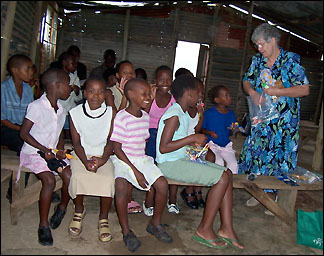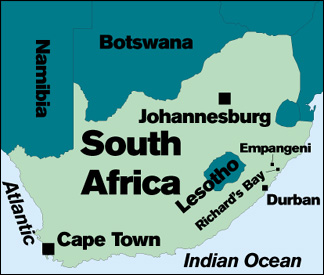Lay minister takes mission trip to South Africa
 Pearson, a member of Nordland Lutheran Church, joined 20 others from the Southwest Minnesota Synod of the Evangelical Lutheran Church of America on a learning mission to its companion synod on the east coast of South Africa. They traveled to the cities of Empangeni, Durban, and Richard's Bay and visited the surrounding communities, as well as doing some sightseeing.
Pearson, a member of Nordland Lutheran Church, joined 20 others from the Southwest Minnesota Synod of the Evangelical Lutheran Church of America on a learning mission to its companion synod on the east coast of South Africa. They traveled to the cities of Empangeni, Durban, and Richard's Bay and visited the surrounding communities, as well as doing some sightseeing.
Marlys Pearson hands out gifts from home to children in a rural church near Durban, South Africa, during her recent mission trip.
The mission was a "show and tell," said Pearson. She was to learn about the people in South Africa - especially the area's blacks who are still recovering from apartheid - and carry the information back home to share with the people of her own synod. During the trip, the group spent much of their time travelling around the countryside to visit churches and people in some of the area's poorest communities with local church officials acting as their guides.
The black people in the townships (small rural communities) around Empangeni, Durban, and Richard's Bay are poor, proud, and happy, Pearson reported. Shanty-towns in the townships host rows of metal and wood shacks that many people call home, she said. One of the churches Pearson visited was also a wood and metal shack, but the people were deeply religious and truly happy in spite of their plight, which has actually improved since the end of apartheid more than a decade ago, she said.
One indicator of their happiness is the vivid colors used everywhere, from shacks to the clothes worn by the people, said Pearson. "Color is part of their lives. It shows that they are happy people," said Pearson. From the vivid colors in the communities to the beautiful rust-colored soil and the greens of the crops and other plants found in the countryside, Pearson marveled in the beauty of South Africa.
The biggest problems faced by the blacks in the South African Synod are AIDS and poverty, said Pearson. AIDS is a serious problem, but it is also a taboo subject that nobody discusses. In fact, one of Pearson's first visits in South Africa was to the funeral of a woman who she believes may have died from the disease, but the woman's family refused to say so. They only told Pearson that the woman had been ill for a long time, she said.
Sadly, the AIDS epidemic probably won't be controlled until people can talk about the disease, Pearson said.
Poverty is rampant in the country, Pearson reported. Even in the suburbs, where Pearson stayed with a host family, the poverty in the surrounding areas was apparent in the fences - topped with barbed wire - that surrounded nearly every home, business, and church in an effort to keep out thieves. Most doors were barred, and some businesses even had electric fences, she said.
But Pearson also learned that many similarities exist between South Africa and the United States. Everyone in the areas she visited carried cell phones, she said, because they are cheap and because the country has a sophisticated wireless network to keep people connected. McDonald's, KFC, and Coke were abundant, just like in any city in the United States.
 The prices for goods were very similar to those at home, Pearson noted, and fortunately nearly everyone she encountered spoke English, in addition to their native Zulu and Afrikaans. Most of the people spoke so fast, though, she sometimes had trouble understanding them.
The prices for goods were very similar to those at home, Pearson noted, and fortunately nearly everyone she encountered spoke English, in addition to their native Zulu and Afrikaans. Most of the people spoke so fast, though, she sometimes had trouble understanding them.
Even though apartheid is over, its effects still linger, according to Pearson. The black people in the country have trouble finding jobs, so many of the men have gone to other areas for work, leaving the villages full of women and children, said Pearson. In fact, each of the churches she visited had an active woman's group that did much of the church's work, including visiting the ill, planning music for services, and organizing funerals and other ceremonies, which would be officiated at by a minister that may have many churches to serve.
"Where was I from 1976 to 1993?" Pearson wondered, especially after visiting the prison at Robbin's Island where Nelson Mandella - South Africa's first black president - was held as a political prisoner for 18 years.
Even in the suburbs, signs of apartheid still exist, with segregation between races still common. Pearson stayed in a nice home with a middle-class black family in Empangeni. In the same neighborhood, though, only two homes were owned by blacks, the other by a Lutheran minister. And in that neighborhood, the minister was the only person Pearson's host family knew, she said.
But, in spite of the hardships, Pearson believes the people can recover. With lots of land in the townships, the people are trying to learn how to use it to earn income. Before that can happen, though, South African blacks need to be educated, which is a problem now.
Since the schools are all private, most poor black children are unable to attend, Pearson said. Setting up a fund for more children to go to school is just one of the things Pearson and her mission group hope to do now that they have returned.
By sharing what they've learned and building communication between the two synods, in order to support each other, the group hopes to help their South African partners improve their lives. So for Pearson and the others who took the trip to South Africa, the mission will continue.
Pearson - who is a lay minister at Nordland and the interim pastor at Zion Lutheran Church and at Hope Presbyterian Church in New London - has shared what she learned with these congregations, with women's groups, and with other organizations.
Sharing the story is just one part of the local synod's plan for helping the companion synod. Long-term plans include making a day of prayer on one Sunday each month for the churches of the companion synod in South Africa, raising money to support the companion synod, and listening and learning more about the people in the companion synod, according to a mission plan.
Pearson will probably do more mission trips, she said, but not to South Africa, because she believes others should have the opportunity to go there and learn about the country. "Everyone needs to see what I saw," she said.
Contact the author at editor@paynesvillepress.com • Return to News Menu
Home | Marketplace | Community